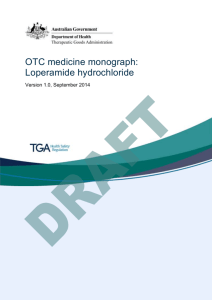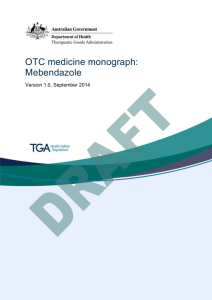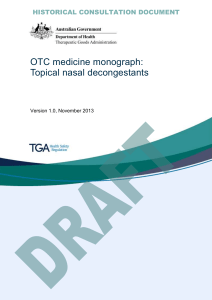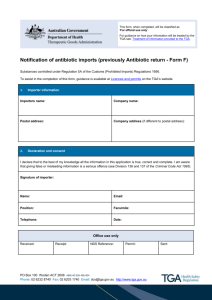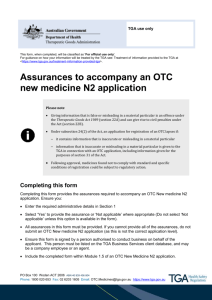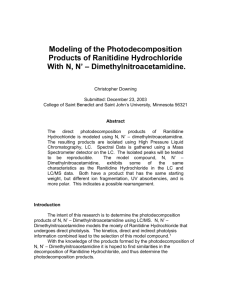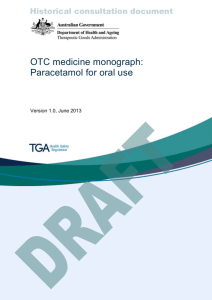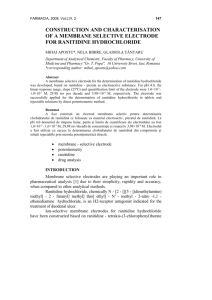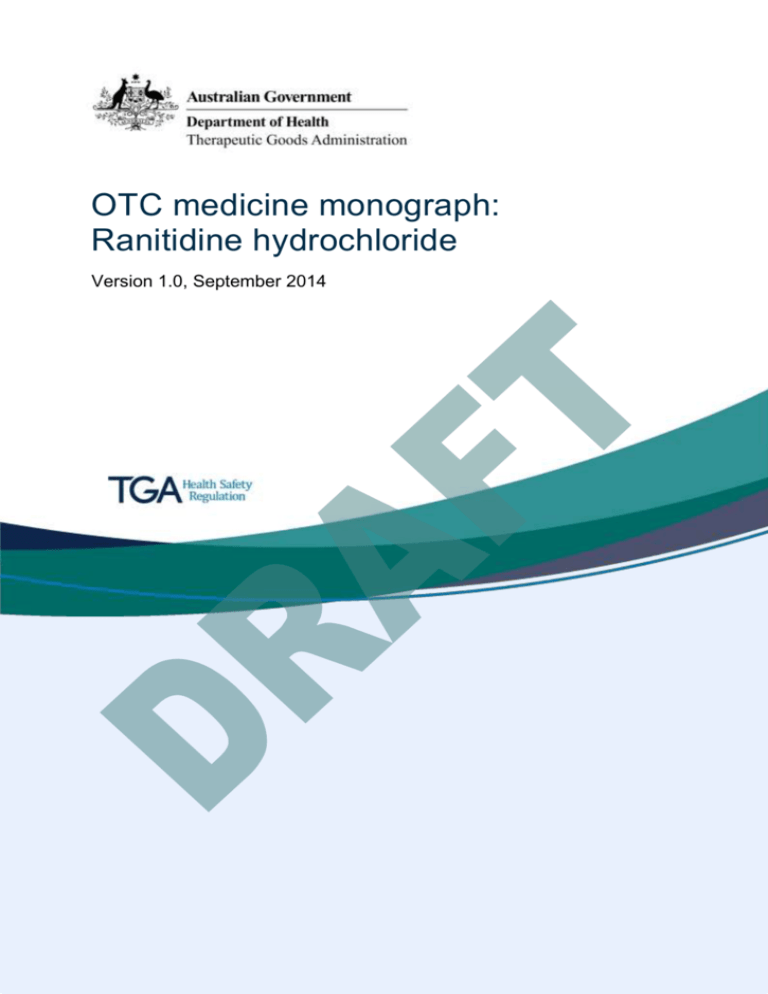
OTC medicine monograph:
Ranitidine hydrochloride
Version 1.0, September 2014
Therapeutic Goods Administration
About the Therapeutic Goods Administration
(TGA)
The Therapeutic Goods Administration (TGA) is part of the Australian Government
Department of Health, and is responsible for regulating medicines and medical devices.
The TGA administers the Therapeutic Goods Act 1989 (the Act), applying a risk management
approach designed to ensure therapeutic goods supplied in Australia meet acceptable
standards of quality, safety and efficacy (performance), when necessary.
The work of the TGA is based on applying scientific and clinical expertise to decisionmaking, to ensure that the benefits to consumers outweigh any risks associated with the use
of medicines and medical devices.
The TGA relies on the public, healthcare professionals and industry to report problems with
medicines or medical devices. TGA investigates reports received by it to determine any
necessary regulatory action.
To report a problem with a medicine or medical device, please see the information on the
TGA website <http://www.tga.gov.au>.
Copyright
© Commonwealth of Australia 2014
This work is copyright. You may reproduce the whole or part of this work in unaltered form for your own personal use or, if
you are part of an organisation, for internal use within your organisation, but only if you or your organisation do not use the
reproduction for any commercial purpose and retain this copyright notice and all disclaimer notices as part of that
reproduction. Apart from rights to use as permitted by the Copyright Act 1968 or allowed by this copyright notice, all other
rights are reserved and you are not allowed to reproduce the whole or any part of this work in any way (electronic or
otherwise) without first being given specific written permission from the Commonwealth to do so. Requests and inquiries
concerning reproduction and rights are to be sent to the TGA Copyright Officer, Therapeutic Goods Administration, PO Box
100, Woden ACT 2606 or emailed to <tga.copyright@tga.gov.au>
Confidentiality
All submissions received will be placed on the TGA’s Internet site, unless marked confidential. Any confidential material
contained within your submission should be provided under a separate cover and clearly marked “IN CONFIDENCE”.
Reasons for a claim to confidentiality must be included in the space provided on the TGA submission coversheet. For
submission made by individuals, all personal details, other than your name, will be removed from your submission before it
is published on the TGA’s Internet site. In addition, a list of parties making submissions will be published. If you do not wish
to be identified with your submission you must specifically request this in the space provided on the submission coversheet.
Therapeutic Goods Administration
Version history
Version
Description of change
Author
Effective date
V1.0
Original publication
OTC Medicines
Evaluation/OMA
XX/XX/XX
OTC medicine monograph: Ranitidine hydrochloride
V1.0 September 2014
Page 3 of 9
Therapeutic Goods Administration
Contents
Introduction ___________________________________ 5
Active substance _______________________________ 5
Dosage forms and strengths _____________________ 5
Indications ____________________________________ 5
Required therapeutic indications for inclusion in the Australian Register of
Therapeutic Goods _____________________________________________________________ 5
Label indications _______________________________________________________________ 5
Directions for use ______________________________ 6
Labelling ______________________________________ 6
Quality requirements ___________________________ 7
Finished product specifications _____________________________________________ 7
Coated tablets --------------------------------------------------------------------------------- 7
Effervescent tablets ------------------------------------------------------------------------- 7
Oral liquid ------------------------------------------------------------------------------------- 7
Container/measuring device _________________________________________________ 8
OTC medicine monograph: Ranitidine hydrochloride
V1.0 September 2014
Page 4 of 9
Therapeutic Goods Administration
Introduction
This OTC Medicine Monograph outlines the requirements for Australian market authorisation of
oral medicines containing ranitidine hydrochloride as a single active ingredient when applied
for as an OTC New Medicine N2 application. Proposed medicines must comply with all aspects of
the monograph relevant to their strength and dosage form to qualify for evaluation as an N2
application.
This monograph should be read in conjunction with the document Requirements for OTC new
medicine N2 applications.
Active substance
This monograph only applies to ranitidine hydrochloride (CAS no. 66357-59-3) and excludes
preparations containing any other salts and derivatives of ranitidine.
Dosage forms and strengths
Acceptable dosage forms and strengths are shown in the table below.
Active
substance
Dosage
strengths*
Dosage forms (excludes modified
release dosage forms)
Ranitidine (as
hydrochloride)
150 mg
Coated tablet, effervescent tablet
300 mg
Coated tablet, effervescent tablet
15 mg/mL
Oral liquid
* Ranitidine content, equivalent to 167.4 mg, 334.8 mg or 16.74 mg/mL ranitidine hydrochloride.
Indications
Required therapeutic indications for inclusion in the
Australian Register of Therapeutic Goods
Relief of symptoms of gastro-oesophageal reflux.
Label indications
Reference should be made, at least once, to relief of ‘symptoms of gastro-oesophageal reflux’
or ‘heartburn due to gastro-oesophageal reflux’ or similar.
Symptomatic relief of heartburn.
The following label indications/claims are also acceptable:
Symptomatic relief of acid indigestion and/or dyspepsia
OTC medicine monograph: Ranitidine hydrochloride
V1.0 September 2014
Page 5 of 9
Therapeutic Goods Administration
‘Works by decreasing the amount of acid made by the stomach’, or similar
‘Long lasting’
For 150 mg tablet and oral liquid: ‘Up to 12 hours relief’ and/or ‘12 hour action’
For 300 mg tablet: A prominent statement is required on the main panel of the carton label
indicating that the medicine is intended for use by patients who routinely require two 150
mg ranitidine tablets for relief of their symptoms. The statement should be presented in
such a way that it clearly stands out to prospective purchasers.
Directions for use
Directions are to be as shown in the table below.
Dosage form
and strength
Directions
150 mg tablet
Adults and children 12 years and over: Take one tablet at the first sign
of symptoms. If symptoms return or persist for more than one hour,
take another tablet. Do not take more than 2 tablets in 24 hours. Do not
use in children under 12 years.
300 mg tablet
Adults and children 12 years and over: Take one tablet at the first sign
of symptoms. Do not take more than 1 tablet in 24 hours. Do not use in
children under 12 years.
15 mg/mL
oral liquid
Adults and children 12 years and over: Take 10 mL at the first sign of
symptoms. If symptoms return or persist for more than one hour, take
another 10 mL. Do not take more than 2 doses (20 mL) in 24 hours. Do
not use in children under 12 years.
For effervescent tablets, refer to placing the tablet in water and waiting till dissolved.
Directions for coated tablets may refer to taking with a glass of water.
Requirements in relation to measuring devices provided with oral liquid products are included
under Container/measuring device.
Labelling
Labelling must comply with all relevant Australian regulatory requirements, as detailed in
the document Requirements for OTC new medicine N2 applications, including all required
warning statements.
In addition to statements required by RASML, the following statement is required:
–
‘If you are pregnant or intend to become pregnant, or are breastfeeding, check with
your doctor or pharmacist before using this product.’
OTC medicine monograph: Ranitidine hydrochloride
V1.0 September 2014
Page 6 of 9
Therapeutic Goods Administration
Where 150 and 300 mg strengths of the same brand name are to be marketed, there must
be sufficient differentiation between the product name and labelling of the two different
strengths (e.g. inclusion of ‘Extra strength’ in the product name of the 300 mg product and
colour differentiation between labelling).
Quality requirements
In addition to the quality requirements outlined in the document Requirements for OTC new
medicine N2 applications, the following specific requirements apply to ranitidine hydrochloride
monograph medicines:
Finished product specifications
In addition to other requirements specified in the document Requirements for OTC new
medicine N2 applications, the finished product specifications must comply, at a minimum, with
the relevant set of requirements below.
The requirements below include all relevant BP general monograph/USP General Chapter
requirements and TGO78 requirements. Further reference to these is not required. References
to pharmacopoeial monographs below refer to the current monograph at time of application.
Coated tablets
The tests and limits in the BP monograph Ranitidine Tablets with the addition of:
tablet appearance
dissolution (900 mL water, paddle at 50 rpm, 80% (Q) after 45 minutes)1
uniformity of dosage units (BP)
microbiological quality, in compliance with TGO 77
Effervescent tablets
The tests and limits in the BP monograph Ranitidine Tablets with the addition of:
tablet appearance
disintegration (BP)
uniformity of dosage units (BP)
microbiological quality, in compliance with TGO 77
Oral liquid
The tests and limits in the BP or USP monograph Ranitidine Oral Solution with the addition of:
solution appearance
1
From Ranitidine Tablets USP
OTC medicine monograph: Ranitidine hydrochloride
V1.0 September 2014
Page 7 of 9
Therapeutic Goods Administration
content of any preservatives included in the formulation
microbiological quality, in compliance with TGO 77
Container/measuring device
If a measuring device is to be supplied with the product, calibrations must be exclusively in
metric units and must allow all the doses shown on the labels to be measured accurately. Details
of the calibrations on the measuring device must be provided with the submission (a sample
may also be requested). Further considerations and requirements regarding measuring devices
are detailed in ARGOM Appendix 2: Guidelines on quality aspects of OTC applications, 8.
Finished product container
OTC medicine monograph: Ranitidine hydrochloride
V1.0 September 2014
Page 8 of 9
Therapeutic Goods Administration
PO Box 100 Woden ACT 2606 Australia
Email: info@tga.gov.au Phone: 1800 020 653 Fax: 02 6232 8605
http://www.tga.gov.au
Reference/Publication #

